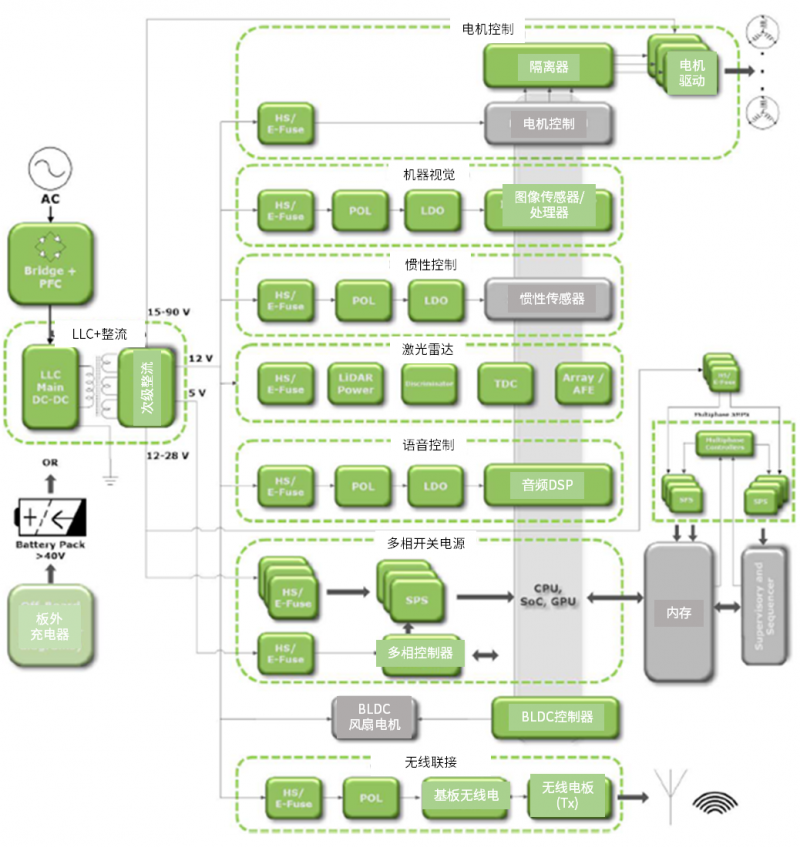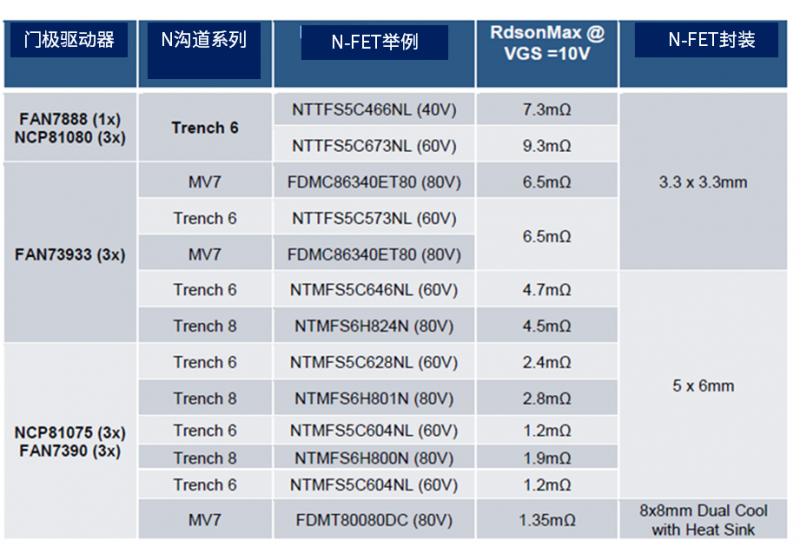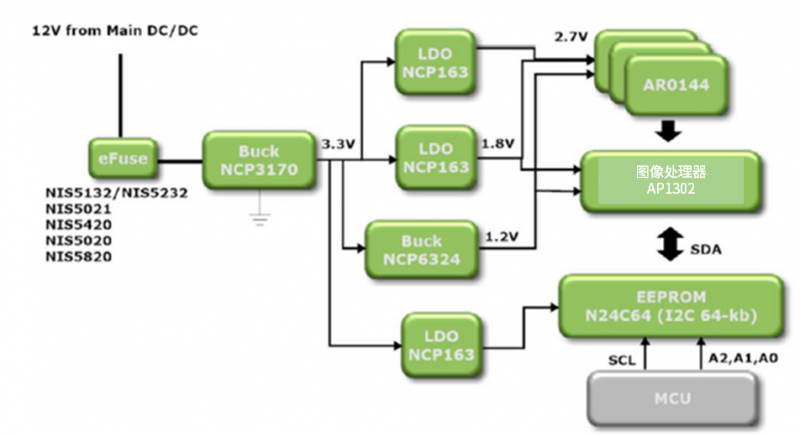Industrial automation simply means the shift from human manufacturing to robot manufacturing, involving a variety of technologies such as cyber-physical systems (CPS), Internet of Things (IoT)/Industrial Internet of Things (IIoT), cloud computing, and artificial intelligence (AI), which can achieve economic growth and maximize profits, improve production efficiency, and avoid safety hazards when humans perform certain tasks. ON Semiconductor provides comprehensive, energy-efficient, and innovative semiconductor solutions for industrial automation. The block diagram of the robotic semiconductor solution is shown in Figure 1.
Figure 1: Industrial Automation - Robotics Semiconductor Solution Block Diagram
Motor control
designers can use ON Semiconductor's brushless DC motor (BLDC) controllers to implement BLDC motor control, such as the high-performance second-generation single motor controllers MC33035, NCV33035 and MC33033, or MC33039 for speed closed-loop control. For matching power devices, ON Semiconductor offers the Power Trench N-channel MOSFET series with avalanche breakdown voltages ranging from 40 V to 150 V or even higher, depending on the application.
A dedicated inverter network is used to drive the BLDC phase windings of the universal arm brake and end effector. This inverter system includes Power Trench power devices with a withstand voltage of up to 150 V. The following table lists some members of ON Semiconductor's Trench series of discrete devices, as well as the recommended three-phase gate (pre) driver:
In order to feed back transient high currents and high voltages to a low-voltage microprocessor that is more sensitive to noise, a digital isolator may be required; depending on the power supply architecture, an isolated driver IC may also be required.
Inverter functions and higher power applications can be implemented using intelligent power modules (IPMs), such as the NFVA35065L32 from ON Semiconductor. This 50 A automotive-grade high-voltage module, certified by AEC-Q and AQG324, integrates 650V field-stop trench IGBT devices to withstand higher inductive voltage spikes. The NFVA35065L32 also integrates a wealth of protection functions such as overcurrent shutdown, undervoltage lockout (UVLO), overtemperature, overheating monitoring, and fault telemetry to meet all your requirements for driving today's three-phase BLDC motor applications, with stable and reliable performance and excellent high reliability. The NFVA33065/34065L32 are 650 V 30 A / 40A IPMs, respectively. The NFVA225 / 235 / 25012NP2T– is a 1200V 25A/35A/50A IPM.
At higher power levels, ON Semiconductor has launched 1200 V 25 A, 35 A and 50 A PIM modules, providing converter-inverter-brake (CIB) and converter-inverter (CI) architectures; as well as 650V 50A PIM modules, providing converter-inverter-interleaved PFC (CIP) architectures, which are ideal for industrial automation-robot applications. In the future, 1200 V and 650 V products with 25 A to 200 A will be launched, including Compact and QLP-74 series, to achieve full coverage of the power spectrum to meet a variety of different power requirements. The following table lists the TMPIM modules that ON Semiconductor has launched.
For higher voltage applications, the intelligent power inverter APM17M series is required, such as the NXV10H250XT1 (100 V, Idmax = 250 A, 1 mΩ) and NXV10H350XT1 (100 V, Idmax = 310 A, 1 mΩ). These power inverter units can be operated in three phases (3 APM17M) or six phases (6 APM17M).
The package design of this series has the advantage of low parasitic inductance (<25nH), each phase can withstand large load transients (large dI/dt), and low electromagnetic interference (EMI). Each APM17M module has 2 upper tubes (MOS) and 2 lower tubes (MOS) inside, which can be driven by FAN73832 (625V driver IC). FAN73832 has +0.35A/-0.65A driving capability and programmable dead time setting to prevent direct conduction of bridge circuits. For current detection of each phase, we can use NCV210R, NCV213R and/or NCV214R to detect the current on the shunt resistor of each phase. The maximum operating voltage of this series of current amplifiers is 26 V, and the offset voltage is as low as 35 uV, which is the best choice for cycle-by-cycle detection of current.
To help designers accelerate the development of more energy-efficient motor control solutions, ON Semiconductor has also launched an advanced and flexible motor development kit (MDK) for development applications within 10 kW. This modular comprehensive prototyping platform includes a universal controller board (UCB) and a series of expanding motor drive evaluation boards, and software development support comes from Xilinx in the form of Vivado® design kit for high-level integration.
One of the key elements of machine vision
to achieve full automation is that the machine can perceive the surrounding environment: the machine can observe and identify nearby objects, and distinguish and identify the next action to maintain safety and avoid conflicts. ON Semiconductor is one of the leaders in industrial machine vision, committed to enabling machines to surpass human vision and promote innovation in industrial automation with a full range of imaging solutions and leading technologies.
As shown in the following figure, the 1/4-inch, 1-megapixel AR0144 CMOS image sensor uses the best third-generation global shutter technology, which is extremely suitable for machine vision applications. The AR0144 is powered by the ultra-low noise and ripple NCP163, allowing the AR0144 to obtain clear images even in low light.
NCP3170 synchronous rectifier Buck provides the main power output for point-of-load (POL) power supply. The buck regulator has an output capacity of 3.3V/3A, which can provide sufficient power for other downstream devices of ON Semiconductor. NCP3170 also has some key features such as thermal shutdown and output short circuit. Electronic fuses (e-Fuse) can also be used on DC BUS to suppress voltage/current surges and solve the timing problems of multiple power supplies.
Figure 2: Industrial Automation - Robotic Machine Vision Semiconductor Block
For low-light and distance-sensitive detection and measurement applications, laser radar
(LiDAR) is deployed to detect light and measure distance using single-photon-sensitive high-performance solid-state sensors or silicon photomultipliers (SiPM)/single-photon avalanche diodes (SPAD) and microcell arrays to generate digital 3D images of the desired target. Due to the high gain, high bandwidth and high sensitivity of the photomultiplier, more accurate images can be generated. ARRAYRDM-0116A10-DFN, a member of the R series SiPM sensor series, is suitable for 905/940 nm LiDAR applications. The 1x16 pixel array format and unique fast output, as well as the sensitivity of 905 nm wavelength is higher than 100 kA/W. These excellent features provide a viable solution for factory automation scanning.
The main power supply consists of several switching regulators, converters and LDOs to provide suitable operating voltages for the photomultiplier array, laser diode, gallium nitride (GaN) driver, analog front-end bias circuit, time-to-digital converter, etc. In order to provide -24V or -45V negative voltage to the Microcell array, the NCV898031 non-synchronous (SEPIC) boost controller can be used. The NCV898031 integrates a MOSFET driver to drive the FDMC86116LZ 100V 7.5A 103mΩ Rdson MOS. The boost rectifier part uses the ultra-fast recovery automotive-grade diode SURA8120T3G (1A 150V Trr<35ns).
The NCV887102D1R2G automotive-grade boost IC can be used to drive the FDMC86116LZ MOSFET to provide 80 V power to the laser diode. The NCV890100MWTXG buck regulator integrates a switching MOSFET and is suitable for outputting 3.7 V and 5.5 V power supplies. This 2 MHz switching frequency power supply can handle input voltages up to 36 V and is suitable for small-size applications. It is an ideal choice for applications that require 3.7 V or 5.5 V output voltages.
The NCP59300 is a low noise and low ripple linear regulator with 3A current output, the NCV8114ASN250T1G is a 300 mA LDO with high PSRR and low quiescent current, and the NCV8187AMT120TAG can provide 1.2 A output. These LDOs provide power for the clock oscillators in the FPGA, NC7WZ17P6X clock buffer, NCV809RTRG voltage monitor/microprocessor and time-to-digital converter, and these LDOs are powered by the DC-DC buck converter output power of the NCV890100MWTXG controller.
Voice-controlled
artificial intelligence (AI) voice interaction applications are becoming increasingly popular and are further penetrating the industrial field. The LC823455 single-chip (SoC), which can be used with the host AI system, is a 32-bit high-resolution audio digital signal processing (DSP) core with multiple proprietary DSP accelerators (codecs) for audio noise reduction, beamforming and echo cancellation. It is a multi-core architecture (2 ARM M3+1 DSP Core) that provides powerful processing capabilities when connected to large-scale programs.
NCP2823 is a Class D audio amplifier for driving 4 Ω to 8 Ω output speakers. The power supply for this audio amplifier is NCP3170 DC-DC to provide 5 V power. Connected to the 5 V POL power supply is a series of linear regulators (LDOs) with high noise suppression capability - NCP170. Its ultra-low quiescent current consumption is ideal for battery-powered applications. It can realize interoperability between devices using the RSL10 platform supporting Bluetooth 5.
无线联接
QCS-AX-D12/QCS-AX2-D12是支持802.11ax/ac/n/a/g/b标准的双频双并发WiFi 6/6E芯片組,是业界首款支持8x8的8空间流和多用户多入多出 (MU-MIMO) 的芯片。其8 x 8 + 4 x 4 双频并发(DBDC)及OFDMA(正交频分多址)可最佳和高效地利用带宽。QCS-AX-D12/QCS-AX2-D12接入点支持达10 Gbps和八条空间流(Eight Simultaneous Spatial Streams)。
In the power supply part of the isolated power
supply, the full-bridge rectifier GBPC3506 is used to rectify the AC into a DC voltage. The 3-channel interleaved CCM PFC IC FAN9673Q can provide a high power factor of PF=1 for the power supply. The 600 V30 A SuperFET III NTPF082N65S3F is recommended for the PFC power MOS. The 650V30A SiC diode FFSP3065A is the PFC rectifier diode. The zero current recovery characteristics of the SiC diode achieve higher efficiency, better EMC characteristics and lower temperature rise.
Previous article:Explore the history and development of Robotic Process Automation!
Next article:What is the structure of the robot's control system?
Recommended ReadingLatest update time:2024-11-16 12:24





- Popular Resources
- Popular amplifiers
-
 Power Electronics Technology 2nd Edition (Li Jie, Chao Xiaojie, Jia Weijuan, Yang Jiayi, Lai Wei)
Power Electronics Technology 2nd Edition (Li Jie, Chao Xiaojie, Jia Weijuan, Yang Jiayi, Lai Wei) -
 Power Integrated Circuit Technology Theory and Design (Wen Jincai, Chen Keming, Hong Hui, Han Yan)
Power Integrated Circuit Technology Theory and Design (Wen Jincai, Chen Keming, Hong Hui, Han Yan) -
 开关电源设计与制作基础 (蔡宣三,倪本来编著)
开关电源设计与制作基础 (蔡宣三,倪本来编著) -
 Installation and Testing of Analog Electronic Products (Edited by Chen Jingzhong and Tang Mingjun)
Installation and Testing of Analog Electronic Products (Edited by Chen Jingzhong and Tang Mingjun)
- Huawei's Strategic Department Director Gai Gang: The cumulative installed base of open source Euler operating system exceeds 10 million sets
- Analysis of the application of several common contact parts in high-voltage connectors of new energy vehicles
- Wiring harness durability test and contact voltage drop test method
- Sn-doped CuO nanostructure-based ethanol gas sensor for real-time drunk driving detection in vehicles
- Design considerations for automotive battery wiring harness
- Do you know all the various motors commonly used in automotive electronics?
- What are the functions of the Internet of Vehicles? What are the uses and benefits of the Internet of Vehicles?
- Power Inverter - A critical safety system for electric vehicles
- Analysis of the information security mechanism of AUTOSAR, the automotive embedded software framework
 Professor at Beihang University, dedicated to promoting microcontrollers and embedded systems for over 20 years.
Professor at Beihang University, dedicated to promoting microcontrollers and embedded systems for over 20 years.
- Innolux's intelligent steer-by-wire solution makes cars smarter and safer
- 8051 MCU - Parity Check
- How to efficiently balance the sensitivity of tactile sensing interfaces
- What should I do if the servo motor shakes? What causes the servo motor to shake quickly?
- 【Brushless Motor】Analysis of three-phase BLDC motor and sharing of two popular development boards
- Midea Industrial Technology's subsidiaries Clou Electronics and Hekang New Energy jointly appeared at the Munich Battery Energy Storage Exhibition and Solar Energy Exhibition
- Guoxin Sichen | Application of ferroelectric memory PB85RS2MC in power battery management, with a capacity of 2M
- Analysis of common faults of frequency converter
- In a head-on competition with Qualcomm, what kind of cockpit products has Intel come up with?
- Dalian Rongke's all-vanadium liquid flow battery energy storage equipment industrialization project has entered the sprint stage before production
- Allegro MicroSystems Introduces Advanced Magnetic and Inductive Position Sensing Solutions at Electronica 2024
- Car key in the left hand, liveness detection radar in the right hand, UWB is imperative for cars!
- After a decade of rapid development, domestic CIS has entered the market
- Aegis Dagger Battery + Thor EM-i Super Hybrid, Geely New Energy has thrown out two "king bombs"
- A brief discussion on functional safety - fault, error, and failure
- In the smart car 2.0 cycle, these core industry chains are facing major opportunities!
- The United States and Japan are developing new batteries. CATL faces challenges? How should China's new energy battery industry respond?
- Murata launches high-precision 6-axis inertial sensor for automobiles
- Ford patents pre-charge alarm to help save costs and respond to emergencies
- New real-time microcontroller system from Texas Instruments enables smarter processing in automotive and industrial applications
- Engineers must know: "5 types" of production processes that must be considered before PCB layout!
- Patent application
- 【Portable Programmable Meter】Project Submission
- There is a basic question about AD9
- After current sampling, the inverted ratio is amplified by 2 times (U9A), and then the output is connected to the form of a hysteresis comparator (U9B), which is...
- DSP-BIOS usage from environment to building the first project
- File status after dup and fork functions are executed
- EEWORLD University Hall----Live Replay: Explore the Black Technology of Network Cameras with Infineon
- Tesla Coil 2 "Low Power Discharge + Detailed Pictures" Welcome to guide
- Problems with the multi-function Bluetooth remote control







 Power Electronics Technology 2nd Edition (Li Jie, Chao Xiaojie, Jia Weijuan, Yang Jiayi, Lai Wei)
Power Electronics Technology 2nd Edition (Li Jie, Chao Xiaojie, Jia Weijuan, Yang Jiayi, Lai Wei)
















 京公网安备 11010802033920号
京公网安备 11010802033920号